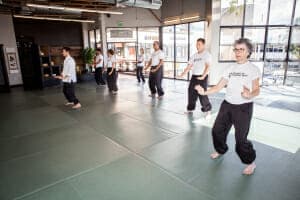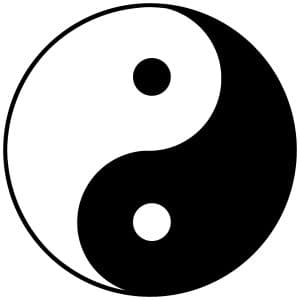What is Tai Chi?
In this article we will break down Tai Chi (T’ai Chi, T’ai Chi Ch’uan, Taiji) into three main areas, each a vital part of the whole:
Physical (stretching, strengthening, improving chronic health conditions)
Mental (stress relief, moving meditation)
Spiritual (dealing with chi or qi, also known as ki and prajna)
We’ll talk about the history, culture and legend behind Tai Chi in another article.
When I began studying Tai Chi as a teenager, I had already practiced martial arts for several years—or so I thought. I had never really gotten the full picture. I knew there was something beyond the physicality of punching and kicking, something deeply graceful and internally powerful. Old kung fu movies hinted at it (there have only been a few descent Tai Chi movies). I had just started practicing Zen Martial Arts with Sifu Brown and was waiting to test for my white sash. Every day I came in to the dojo I was sure he’d ask me to test. It didn’t happen. Then, a few people who had started around the same time as me were asked to test, and I wasn’t. Instantly miffed, I wondered what these students had that I didn’t. When I arrived early to class one day, I saw them all on the mats already for the previous class. They were all learning Tai Chi too. At first, I thought Sifu was playing favorites. What, I have to start taking Tai Chi or I won’t be tested? Still, this was enough to put me over the edge since I was already interested in Tai Chi. Sure enough, about a week after I began taking both classes together, Sifu asked me to test. But by that time, I was already in love with Tai Chi and didn’t even think about it.
Physical
After a few classes, I really began to experience the link between my Tai Chi and Kung Fu practice. The principles of movement were the same, and the slower pace allowed me to come to terms with the fact that I had really never shifted my weight or rotated from my center. At this point, I thought, “Well, it makes sense those students got white sashes before me. Tai Chi just makes you better.”
As a teacher, I now look out onto the mats during Adult Martial Arts and see that the students who move in a more relaxed, smooth way have either been here for years or are also learning Tai Chi. These students often have an easier time picking up more complicated techniques, have better pivots, stances and footwork, and sometimes even breath. It’s incredible.
One of the ways Tai Chi helps us move more fluidly is that it is constantly stretching the entire body. Besides the extended stretching we do in the beginning of class, the postures themselves are designed to move our limbs using the full range of motion. Unlike yoga, which is much more static, Tai Chi is a constant flow. We move our bodies in a complete way that we wouldn’t really do otherwise. Thus, we often experience other movements in life to be easy in comparison.
Tai Chi is also a great way to strengthen the body. Slow movements, often balancing on one leg, especially strengthen the core and lower body. This is very different from doing calisthenics or lifting weights. For one, it is completely safe. Nobody has ever been hurt doing Tai Chi correctly. You will feel it in your joints if you do Tai Chi incorrectly, much in the same way playing basketball or walking down the street incorrectly can be hazardous to your health. This is one of the reasons why we teach primarily through one-on-one instruction at our school: to practice safely and get all the details.
Even students with quite serious health conditions can use Tai Chi to relieve symptoms and even completely work beyond them. See the bottom of this Harvard Medical article for some proven benefits with regard to specific conditions, from arthritis and Parkinson’s to hypertension and sleep problems: http://www.health.harvard.edu/staying-healthy/the-health-benefits-of-tai-chi
The type of strengthening that comes from Tai Chi is more subtle and internal. You won’t bulk up like you would from lifting weights, though the whole body becomes more tone and supple. Other physical activities become more effortless and safe through practicing the 8 principles:
- All movement comes from the center (seca-tunda, dan-tien or hara)
- All movement is circular
- 98% extension (never fully lock out the joints)
- Hip over heel (full weight shift)
- Spine straight (reaching up with the head, rolling the shoulders back and tucking up the hips/pelvis)
- Nothing ever stops
- Heel of the foot sets down first
- Breath leads the body
By practicing Tai Chi regularly, at least one class per week and 2-3 times at home, these principles start to become ingrained in our physical being. Like magic, we begin to move correctly and powerfully in everything we do.
Mental
One of the things that makes Tai Chi unique in martial arts is its internal focus. Unfortunately, many schools have watered down their Tai Chi and made it a purely physical endeavor, even practicing it only for self defense or competition. This is completely absurd. Tai Chi, like all true martial arts, is on a deep level about discovery and destruction of the ego (our small self). Focusing purely on self defense or looking good while doing an individual form is barely scratching the surface and can even be counter-productive. Instead, a true Tai Chi practice dives inward. As Sifu Brown says, “the battle is within.”
One of the main ways to become aware of our thoughts and emotions and gain mastery over our inner state is to focus on the breath. Like in meditation, this helps us quiet the mind and become more aware. Relaxation, both physical and mental, is one of the first things we learn in Tai Chi. Stress relief follows from this. By staying by returning to the breath and correct movement, we remain unattached to our thoughts. When we live in the moment, the stress melts away.
Done correctly, Tai Chi is on one level a moving meditation. One of the reasons it is so powerful is because it acts as a bridge between our sitting meditation and everyday life. When we sit and breath, it is much easier to cultivate a focused relaxation. Yet when we stand up from our meditation and start dealing with the world around us, we have a tendency to quickly lose that calm. Tai Chi allows us to practice getting the same kind of internal state in movement. Now, we can be mindful and even find joy in the things that used to annoy us (for me, washing dishes).
Another simple way that Tai Chi affects us mentally is through improved memory. Early on, we learn the 108, our first individual form. This is a traditional long form that takes quite a while to memorize. Through much time and effort, we eventually get the whole sequence. This process forms new synapses and strengthens old ones. As our minds get stronger, we essentially get better at learning.
Practicing Tai Chi is like holding up a mirror and taking a good, long look. Through the process of learning our individual forms, we learn much about ourselves. Working with different students is a huge pleasure for me. I see students realize for the first time what perfectionists they are and how completely this affects their lives. I’ve also seen students who believe themselves to be lazy and uninterested in details begin to really pour themselves into perfecting the form (this was me). Everybody who takes on learning Tai Chi sets out on a unique journey specific to that person. Like life, it’s what they encounter along the way that makes things interesting.
Spiritual
According to eastern philosophies, Chi (Qi, Ki, Prajna) is the energy that courses through every living thing in the universe. It is the thing that keeps us alive and healthy. When the flow of Chi is blocked, we are unhealthy. When Chi leaves the body, we die.
Tai Chi is a method of promoting and controlling the flow of Chi not only for physical health, but for mental and spiritual growth. It is said that enlightenment comes when the individual Chi is merged with the Universal Chi. Tai Chi is a practice through which we can experience this internal process externally as well. It is the dance of the Tao, the embracing and understanding of duality (black/white, hard/soft, yin/yang).
When we practice T’ai Chi, we can catch a glimpse of what is beyond duality. When we immerse ourselves in movement and breathing, drowning out the senses and thoughts, we allow our small self to melt away and experience the big Self. Even if only for a moment, we get to a space of nothingness. In this space, everything is present and anything is possible.



Such a beautiful article.
Cheers.